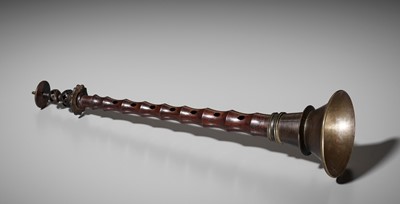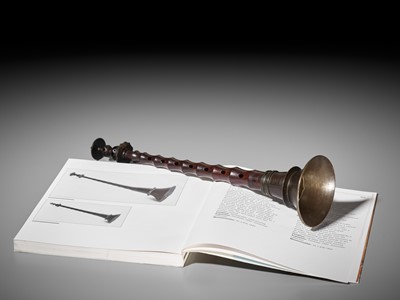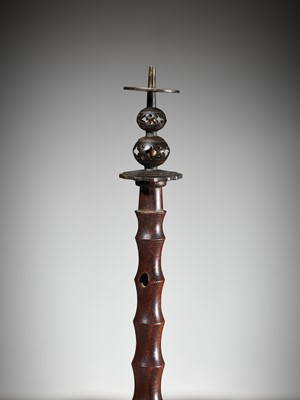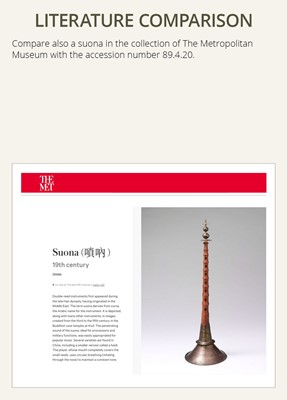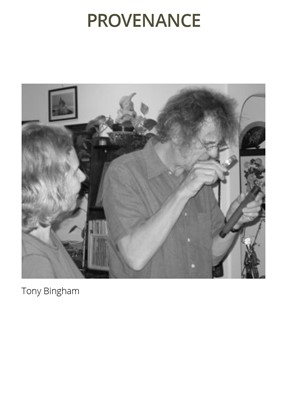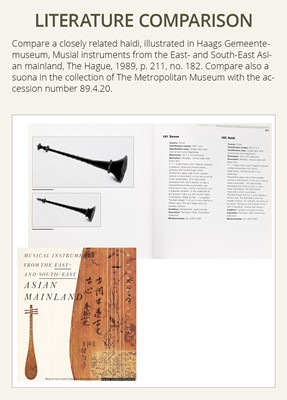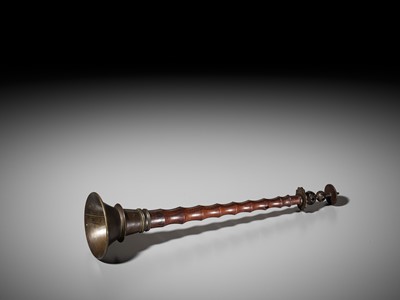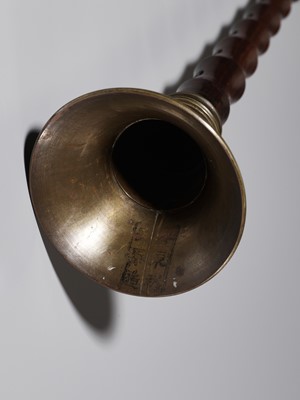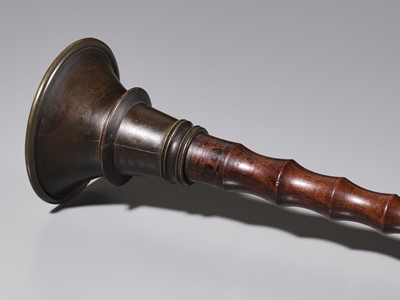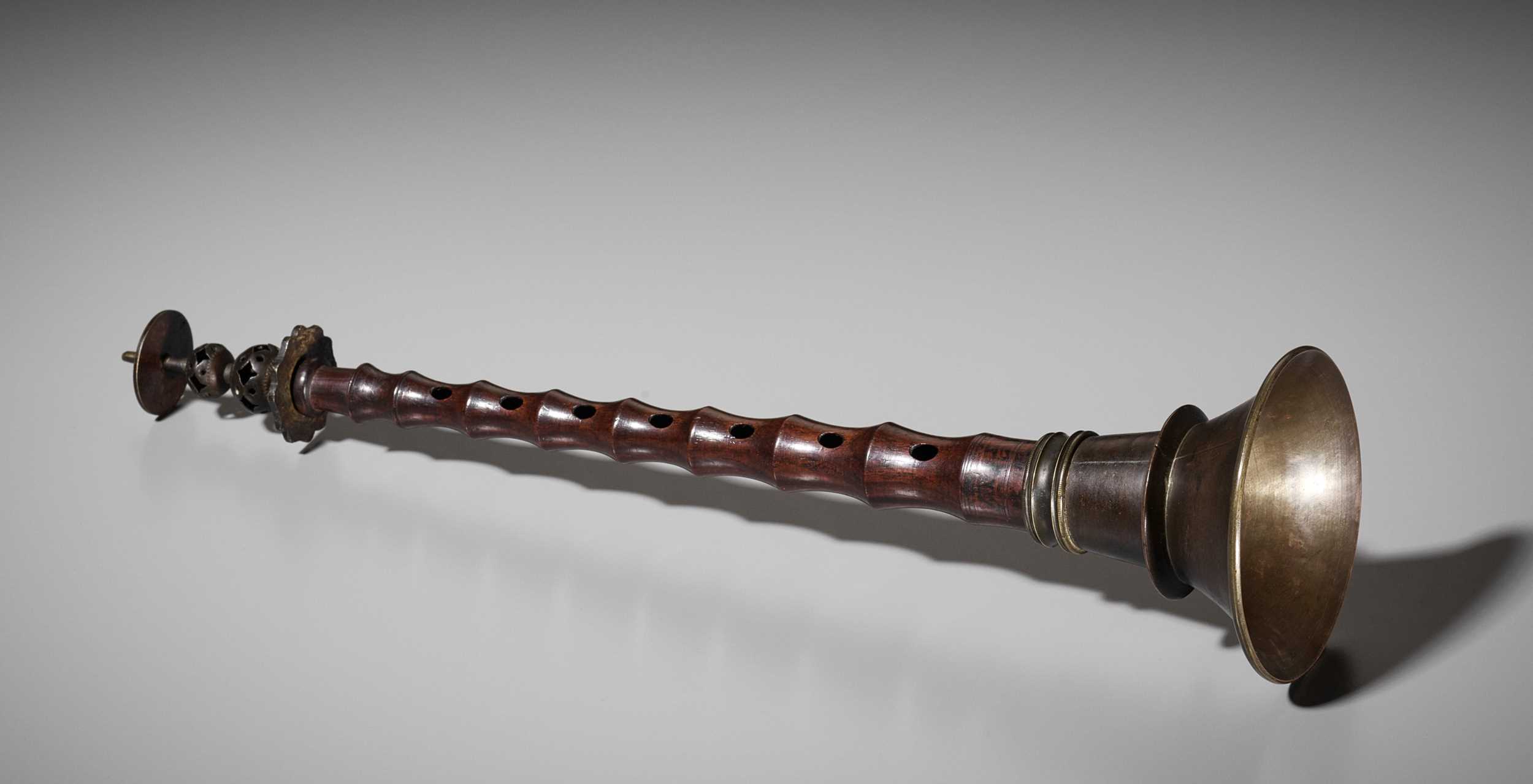10th Dec, 2022 11:00
Asian Art Holiday Sale
130
A BRASS AND WOOD OBOE, HAIDI, 18TH-19TH CENTURY
十八至十九世紀海笛
Sold for €2,080
including Buyer's Premium
China. The mouthpiece of brass, decorated with two pierced, globular elements between two discs, the lower disc with a lobed rim, the wood handle carved with outward scalloping between the finger holes, and a brass bell. The interior of the brass bell with an illegible mark.
Provenance: From the collection of Tony Bingham, United Kingdom. Tony Bingham is a retired dealer of antique musical instruments. He and his wife Irene opened several stores in London beginning in the 1960s, where they were selling antique instruments to museums, private collectors, and musicians, for more than 40 years. He also published several books on the history of musical instruments, including The New Langwill Index, a Dictionary of Musical Wind-Instrument Makers and Inventors.
Condition: Excellent condition with minor wear, traces of usage and minuscule nicks, the brass bell loose. Nice patina overall.
Weight: 112.8 g
Dimensions: Length 34.2 cm
The haidi is the smallest and highest-pitched version of the suona, a double reed instrument that was introduced to China around the beginning of the 16th century and takes its name from the Middle Eastern zurna. The player, whose mouth completely covers the small reeds, uses circular breathing (through the nose) to maintain a constant tone. It was first used by the military, but today it is played both in ensemble and as a solo instrument.
Literature comparison:
Compare a closely related haidi, illustrated in Haags Gemeentemuseum, Musial instruments from the East- and South-East Asian mainland, The Hague, 1989, p. 211, no. 182. Compare also a suona in the collection of The Metropolitan Museum with the accession number 89.4.20.
十八至十九世紀海笛
中國。由雙簧哨子、蕊子、桿子和銅碗四部分組成。銅碗上有印,但已模糊不清。
來源:英國Tony Bingham收藏。Tony Bingham是一位退休的古董樂器經銷商。他和他的妻子Irene上世紀六十年代初在倫敦開設了幾家商店。四十多年來,他們一直在向博物館、私人收藏家和音樂家出售古董樂器。他還出版了幾本關於樂器歷史的書籍,包括《新朗威爾索引》,一部音樂管樂器製造商和發明家詞典。
品相:狀況極好,有輕微磨損、使用痕跡和微小的刻痕,黃銅哨子鬆動。整體包漿渾厚。
重量:112.8克
尺寸:長34.2厘米
最初的嗩吶是流傳於波斯、阿拉伯一帶的樂器,就連嗩吶這個名稱,也是古代波斯諾Surnā的音譯。嗩吶大約在公元三世紀在中國出現,新疆拜城克孜爾石窟第38窟中的伎樂壁畫已有吹奏嗩吶形象。海笛是嗩吶的最小和最高音調的版本,它最初是在軍隊使用的,但今天它既可以作為合奏樂器演奏,也可以作為獨奏樂器演奏。
文獻比較:
比較非常相近的海笛,見海牙美術館,《Musial instruments from the East- and South-East Asian mainland》,海牙, 1989年,頁211,編號182。比較另一件嗩吶, 收藏於大都會藝術博物館,編號89.4.20。
China. The mouthpiece of brass, decorated with two pierced, globular elements between two discs, the lower disc with a lobed rim, the wood handle carved with outward scalloping between the finger holes, and a brass bell. The interior of the brass bell with an illegible mark.
Provenance: From the collection of Tony Bingham, United Kingdom. Tony Bingham is a retired dealer of antique musical instruments. He and his wife Irene opened several stores in London beginning in the 1960s, where they were selling antique instruments to museums, private collectors, and musicians, for more than 40 years. He also published several books on the history of musical instruments, including The New Langwill Index, a Dictionary of Musical Wind-Instrument Makers and Inventors.
Condition: Excellent condition with minor wear, traces of usage and minuscule nicks, the brass bell loose. Nice patina overall.
Weight: 112.8 g
Dimensions: Length 34.2 cm
The haidi is the smallest and highest-pitched version of the suona, a double reed instrument that was introduced to China around the beginning of the 16th century and takes its name from the Middle Eastern zurna. The player, whose mouth completely covers the small reeds, uses circular breathing (through the nose) to maintain a constant tone. It was first used by the military, but today it is played both in ensemble and as a solo instrument.
Literature comparison:
Compare a closely related haidi, illustrated in Haags Gemeentemuseum, Musial instruments from the East- and South-East Asian mainland, The Hague, 1989, p. 211, no. 182. Compare also a suona in the collection of The Metropolitan Museum with the accession number 89.4.20.
十八至十九世紀海笛
中國。由雙簧哨子、蕊子、桿子和銅碗四部分組成。銅碗上有印,但已模糊不清。
來源:英國Tony Bingham收藏。Tony Bingham是一位退休的古董樂器經銷商。他和他的妻子Irene上世紀六十年代初在倫敦開設了幾家商店。四十多年來,他們一直在向博物館、私人收藏家和音樂家出售古董樂器。他還出版了幾本關於樂器歷史的書籍,包括《新朗威爾索引》,一部音樂管樂器製造商和發明家詞典。
品相:狀況極好,有輕微磨損、使用痕跡和微小的刻痕,黃銅哨子鬆動。整體包漿渾厚。
重量:112.8克
尺寸:長34.2厘米
最初的嗩吶是流傳於波斯、阿拉伯一帶的樂器,就連嗩吶這個名稱,也是古代波斯諾Surnā的音譯。嗩吶大約在公元三世紀在中國出現,新疆拜城克孜爾石窟第38窟中的伎樂壁畫已有吹奏嗩吶形象。海笛是嗩吶的最小和最高音調的版本,它最初是在軍隊使用的,但今天它既可以作為合奏樂器演奏,也可以作為獨奏樂器演奏。
文獻比較:
比較非常相近的海笛,見海牙美術館,《Musial instruments from the East- and South-East Asian mainland》,海牙, 1989年,頁211,編號182。比較另一件嗩吶, 收藏於大都會藝術博物館,編號89.4.20。
Zacke Live Online Bidding
Our online bidding platform makes it easier than ever to bid in our auctions! When you bid through our website, you can take advantage of our premium buyer's terms without incurring any additional online bidding surcharges.
To bid live online, you'll need to create an online account. Once your account is created and your identity is verified, you can register to bid in an auction up to 12 hours before the auction begins.
Intended Spend and Bid Limits
When you register to bid in an online auction, you will need to share your intended maximum spending budget for the auction. We will then review your intended spend and set a bid limit for you. Once you have pre-registered for a live online auction, you can see your intended spend and bid limit by going to 'Account Settings' and clicking on 'Live Bidding Registrations'.
Your bid limit will be the maximum amount you can bid during the auction. Your bid limit is for the hammer price and is not affected by the buyer’s premium and VAT. For example, if you have a bid limit of €1,000 and place two winning bids for €300 and €200, then you will only be able to bid €500 for the rest of the auction. If you try to place a bid that is higher than €500, you will not be able to do so.
Online Absentee and Telephone Bids
You can now leave absentee and telephone bids on our website!
Absentee Bidding
Once you've created an account and your identity is verified, you can leave your absentee bid directly on the lot page. We will contact you when your bids have been confirmed.
Telephone Bidding
Once you've created an account and your identity is verified, you can leave telephone bids online. We will contact you when your bids have been confirmed.
Classic Absentee and Telephone Bidding Form
You can still submit absentee and telephone bids by email or fax if you prefer. Simply fill out the Absentee Bidding/Telephone bidding form and return it to us by email at office@zacke.at or by fax at +43 (1) 532 04 52 20. You can download the PDF from our Upcoming Auctions page.
How-To Guides
How to Create Your Personal Zacke Account
How to Register to Bid on Zacke Live
How to Leave Absentee Bids Online
How to Leave Telephone Bids Online
中文版本的操作指南
创建新账号
注册Zacke Live在线直播竞拍(免平台费)
缺席投标和电话投标
Third-Party Bidding
We partner with best-in-class third-party partners to make it easy for you to bid online in the channel of your choice. Please note that if you bid with one of our third-party online partners, then there will be a live bidding surcharge on top of your final purchase price. You can find all of our fees here. Here's a full list of our third-party partners:
- 51 Bid Live
- EpaiLive
- ArtFoxLive
- Invaluable
- LiveAuctioneers
- the-saleroom
- lot-tissimo
- Drouot
Please note that we place different auctions on different platforms. For example, in general, we only place Chinese art auctions on 51 Bid Live.
Bidding in Person
You must register to bid in person and will be assigned a paddle at the auction. Please contact us at office@zacke.at or +43 (1) 532 04 52 for the latest local health and safety guidelines.
